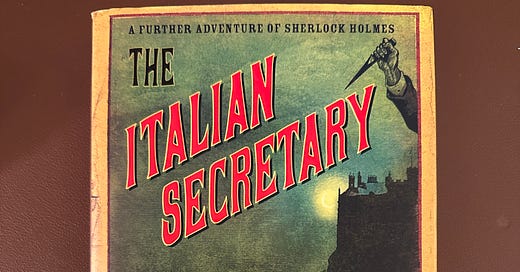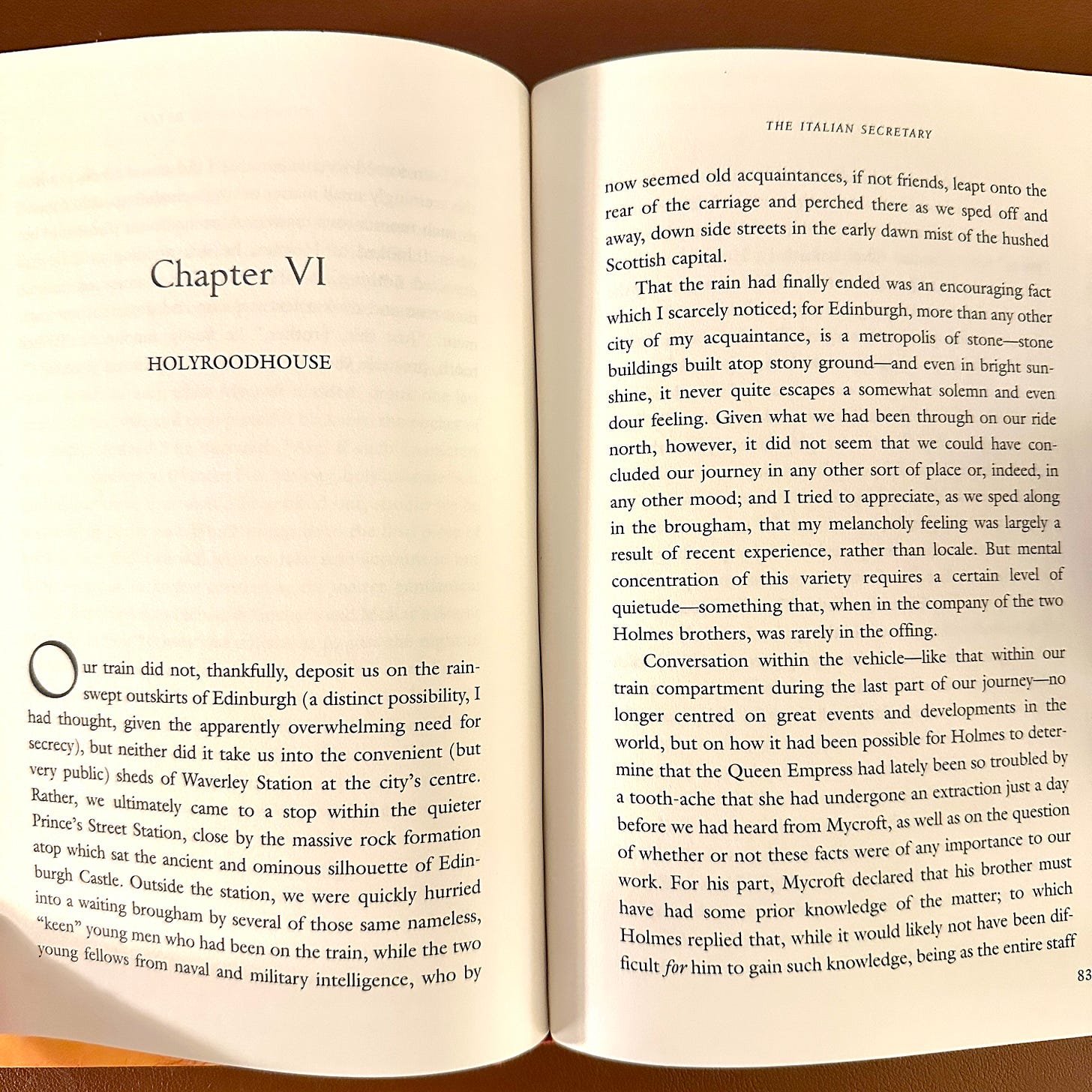The Book: The Italian Secretary by Caleb Carr
‘Biblio’ is a feature of Monochrome covering books I’ve rediscovered and the lessons I’ve learned from them. My goal is to spark your interest and delight in reading or rereading books you may have forgotten.
For those fans of the world’s first “consulting detective” and his trusty physician side-kick, you could do a lot worse than a Conan Doyle Estate-commissioned ‘Further Adventure of Sherlock Holmes’ set on the grounds of a Royal Palace in Scotland.
Add to it, two recent deaths with a possible connection to a ghastly murder involving the Queen of Scots over four hundred fifty years prior: Now I’m interested!
Yet, would this book embody the real Sherlock?
I’ll admit it, my feelings were unfixed as I considered whether to sign up for this Scottish caper as conceived by author Caleb Carr, well-known for his study of criminal psychology (The Alienist), though new to Victorian recreations.
More to the point, I hold a general skepticism as to the fidelity of imitative works and, therefore, remained guarded lest my attention be diverted with springing comparisons to Doyle’s beloved characters and their endearing, if predictable, universe.
I was wrong to be so concerned.
Carr absolutely covers the complexity, rhythm, mannerisms, and word-play of Sherlock Holmes, Dr. Watson, while expertly conjuring the ambience of Victorian London and Scotland.
Carr’s The Italian Secretary boasts a surprisingly well-sequenced plot-line and unguessable finale befitting the fertile imagination of Sir Arthur Conan Doyle, himself.
A moment’s reflection upon sequels penned by authors who are non-original to a popular franchise would have allayed my fears: David Lagercrantz’s three subsequent volumes in the late Steig Larson’s Millennium series, for instance, have largely succeeded in thrilling Lisbeth Salander fans. Other precedents abound.
Though Holmes is portrayed as a Londoner abiding in the renown 221B Baker Street apartment, those readers most familiar with Sherlock’s origin story will be aware that Scottish native Conan Doyle modeled the great sleuth after a real person: Dr. Joseph Bell, who had been his professor at the University of Edinburgh Medical School, taking particular inspiration from Bell’s method of diagnosing a patient’s disease.1
It’s a happy geographical coincidence then, that Carr sets this Sherlock Holmes adventure in Scotland, particularly the foreboding Palace of Holyroodhouse—the King’s official residence while in Scotland and the famous scene of the grizzly murder of Italian courtier David Rizzio, a private secretary (and more?) of Mary, Queen of Scots—he was stabbed 56 times by the Queen’s husband, Lord Darnley near her private chambers.23
Carr succeeds in evoking an unmistakable Holmesian atmosphere, without overreaching, from page 83 as narrated by Dr. Watson:
…That the rain had finally ended was an encouraging fact which I scarcely noticed; for Edinburgh, more than any other city of my acquaintance, is a metropolis of stone—stone buildings built atop stony ground—and even in bright sunshine, it never quite escapes a somewhat solemn and even dour feeling. Given what we had been through on our ride north, however, it did not seem that we could have concluded our journey in any other sort of place or, indeed, in any other mood; and I tried to appreciate, as we sped along in the brougham, that my melancholy feeling was largely a result of recent experience, rather than the locale…
Though Conan Doyle was familiar with David Rizzio, having published a story in The Strand in 1908 which featured the murder,4 the entire concoction is authentically Carr’s and what a thrilling tale!
What Makes This a Good Read
A cozy Caleb Carr-inspired Sherlock Holmes murder mystery, faithful to the originally-chronicled series.
A delightful tour of Victorian Edinburgh and the Palace of Holyroodhouse.
Well-researched ‘edutainment’ of Scottish history some four hundred fifty years ago.
Unfolding machinations of drama and intrigue as played out by royal courtesans to Mary, Queen of Scots.
That’s a wrap for this post! I hope it stokes your interest in discovering, or reviving, your favorite Sherlock Holmes adventure. Let me know in the Comments.
Britannica, The Editors of Encyclopaedia. "Was Sherlock Holmes a real person?". Encyclopedia Britannica, 14 Aug. 2020, https://www.britannica.com/question/Was-Sherlock-Holmes-a-real-person. Accessed 8 February 2024.
https://palaceofholyroodhouse.co.uk/mary-queen-of-scots
https://www.nrscotland.gov.uk/research/learning/hall-of-fame/hall-of-fame-a-z/riccio-david
https://www.arthur-conan-doyle.com/index.php/The_Silver_Mirror






I'm not typically drawn to mystery novels, but I appreciate them when they're incorporated into a larger science fiction narrative, like in the three-book series "The Last Policeman" or Isaac Asimov’s “The Caves of Steel,” published in 1954. The last pure mystery book I remember reading was a Hardy Boys novel from the 1930s, which an elderly neighbor gave to me in 1981. Wish I could revisit that book today. Loved the ambiance. Probably in some box I left in Puerto Rico back in 1984 when we thought it was going to be our new home. I can’t remember the title. Does highlight the importance of a physical book plus keeping notes in something like a commonplace book, as I do today.